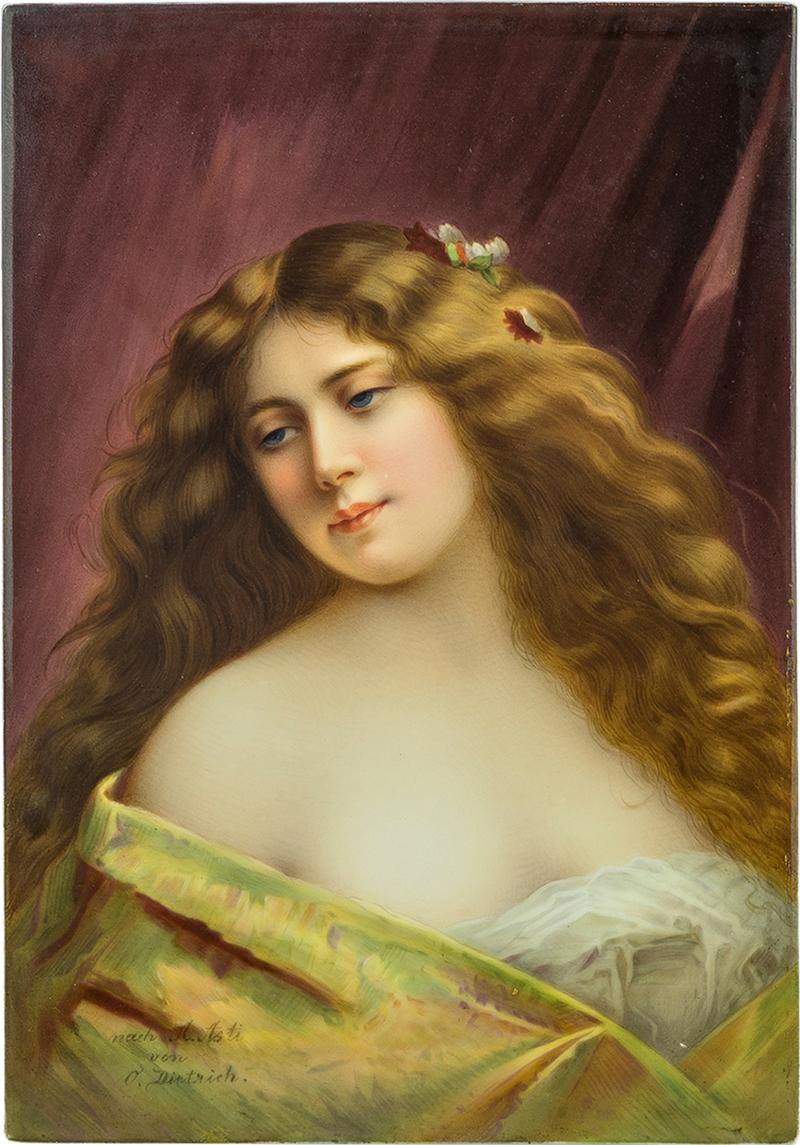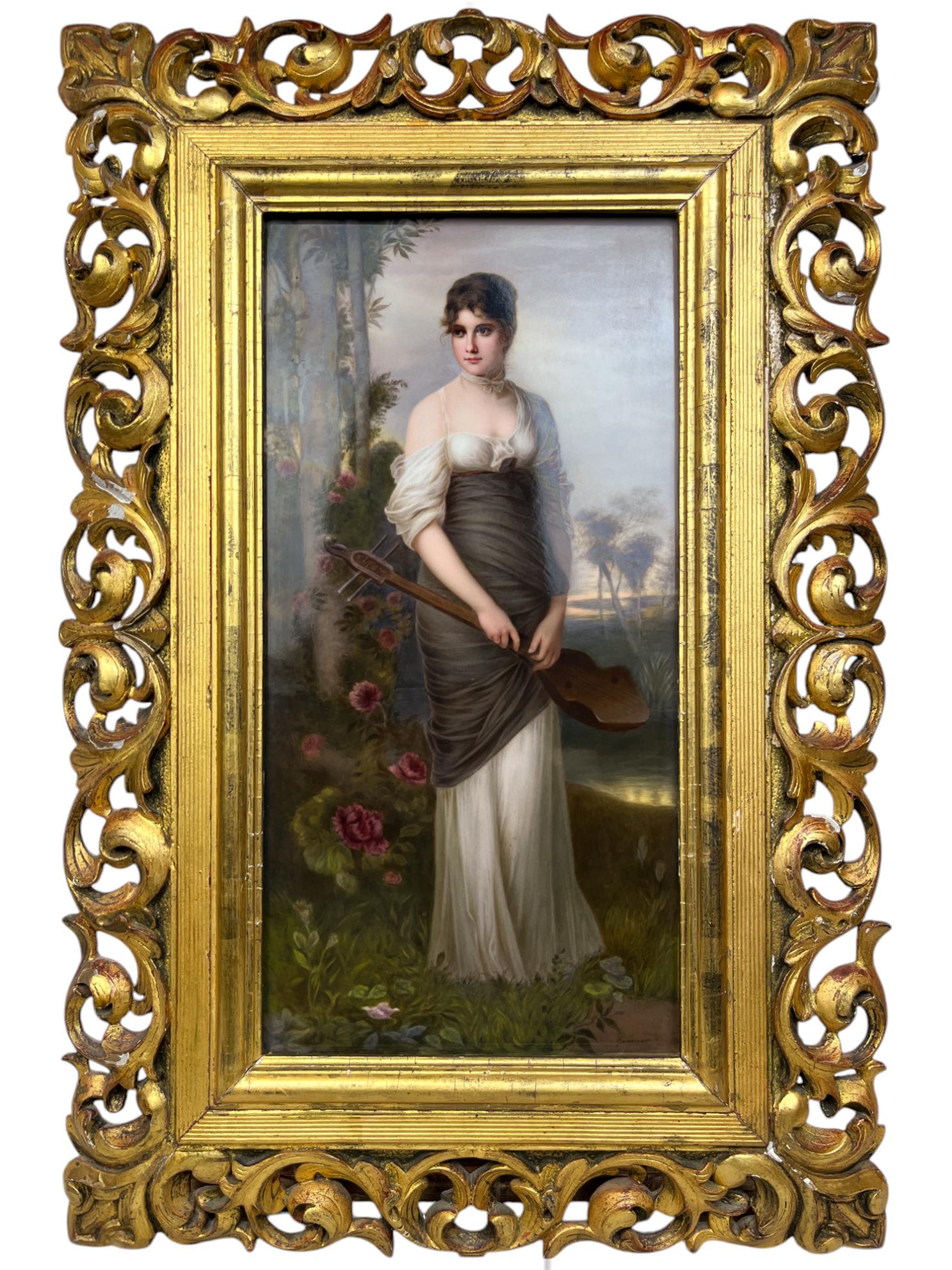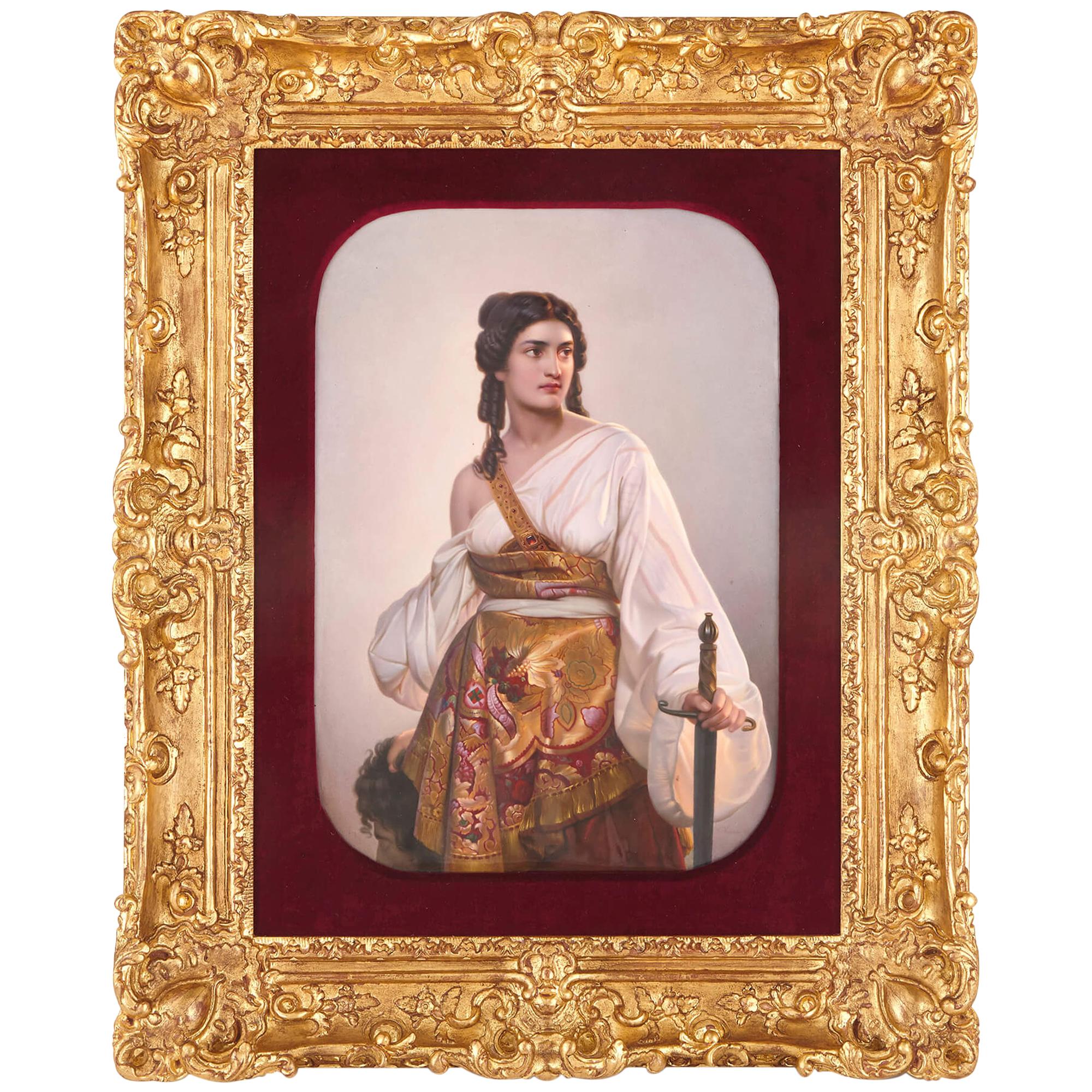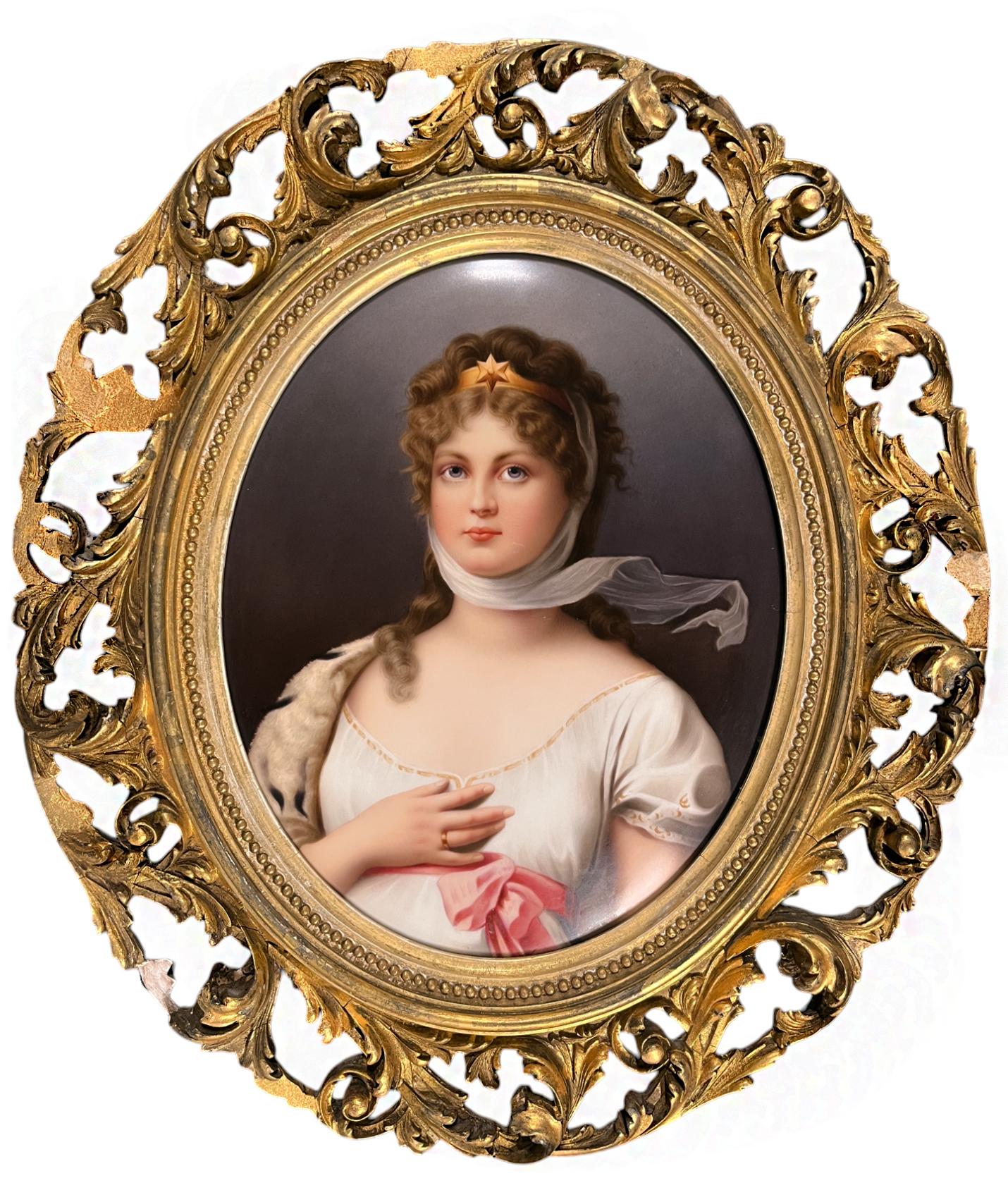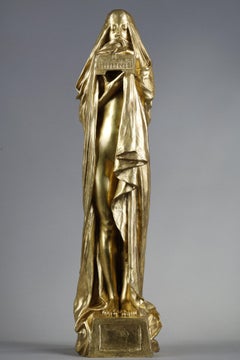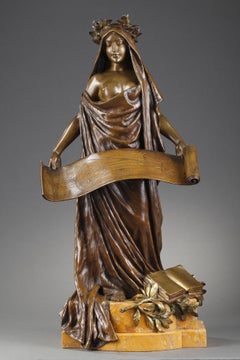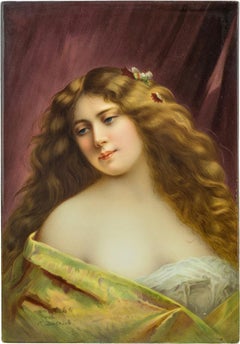Items Similar to Plaque "Judith"
Want more images or videos?
Request additional images or videos from the seller
1 of 15
Theodore DeckPlaque "Judith"1885
1885
$52,853.51
£40,351.76
€45,000
CA$74,625.36
A$81,892.03
CHF 42,772.60
MX$979,110.13
NOK 541,790.80
SEK 505,321.88
DKK 342,808.68
About the Item
"Judith"
by Théodore DECK (1823-1891)
and Albert ANKER (1831-1910)
Important and rare polychromatic enamelled earthenware pannel
Titled "Judith"
Signed in the decor "Anker".
Tripartite pannel signed and dated on the back "TH.Deck 1885" and stamped "TH.Deck".
Presented in a molded wooden frame
France
1885
ceramic pannel : height 96 cm, width 51 cm
frame : height 119 cm, width 73,5 cm
Biography :
Théodore Deck (1823-1891) was a French ceramist born in Guebwiller in Alsace. He is passionate about chemistry and physics. In 1841 he was apprenticed to the master stove fitter Hugelin father in Strasbourg. In two years, it learned of the legacy of the sixteenth century methods, such as inlay colored pastes in the manner of Saint-Porchaire. This learning does not stop him to occupy his free time drawing or modeling clay in the studio of sculptor André Friederich. Escaping military service, he toured Germany as it is traditional in-Stove Fitting potters Alsatian companions. The quality of his work allows him to get large orders in Austria for the castles of the provinces and the imperial palaces, including the palace of Schönbrunn. He moves on to Hungary Pest Prague, then back north through Dresden, Leipzig, Berlin and Hamburg. With his learning, he arrived in Paris in 1847. Recommended by Hugelin it comes to stoves factory Bavarian potter Vogt, located rue de la Roquette. The Revolution of 1848 interrupted production and Deck decides to return to his hometown. His family advised her to start a small workshop terracotta: there realizes some busts, statuettes, vases, lamps and famous ancient copies. Aware that this situation does not allow him to properly meet his needs, he returned to Paris in 1851 where he is employed by the Dumas widow, daughter of the potter Vogt for which he had worked. Hired as a foreman, it provides designs for the workers, while working the land itself.
The following year, he decided to settle near his former employer at 20, rue de la Fontaine au Roi, probably using their ovens. His brother Xavier Deck, joined him. It's officially in 1858 as Deck brothers create their business and moved to Paris at 46 Boulevard Saint-Jacques. At first, the brothers realize that pans coatings. But the business works so well that barely a year after installation they want to diversify their production and get into the ceramic coating of buildings and in the form of coins. Deck is interested in politics. In 1870, he opted for French nationality. Sympathizer of the Radical Party, he was elected deputy mayor in the 15th arrondissement of Paris.
In 1861, at the Salon des Arts and Paris Industry held on the Champs Elysees, Théodore Deck exhibited for the first time his achievements: these pieces with inlay decoration called "Henry II" and other parts covered with a turquoise blue enamel or decoration in the style of Iznik ceramics. If he wins a silver medal, critics are however mixed. The following year, on the occasion of the Universal Exhibition of 1862 in London, he conquers the English customers. It surprises by presenting as the previous year's Alhambra vase of exceptional dimensions (1.36 m high and 2.25 m in circumference) that is purchased by the South Kensington Museum a few years later. At the same exhibition is however noticed the many cracks in the glaze and poor adhesion to the dough. At the Exhibition of Industrial Arts in 1864 Deck manages to present parts not covered with cracked transparent enamels.
Théodore Deck explain the manufacture and properties of these transparent enamels in 1887 when publishing his treatise The earthenware. A year later, he made the first tests in reliefs transparent enamels. He will never abandon this technique which will also be taken up by many large factories. Drawing up pastiche of Islamic ceramics, Egyptian, Chinese, Japanese or majolica, it evolved characters, birds, flowers, ornaments of all kinds in a turquoise glaze, green, yellow or manganese. It is mainly a characteristic blue that the public retains of this technique: a brilliant turquoise shade it adopts immediately under the name "Blue Deck".
Théodore Deck string of innovations. On the occasion of the Universal Exhibition of 1867, the factory receives a silver medal thanks, among others, with metallic reflections he gets on some parts. If these exhibitions become the engine of these technical advances, they nevertheless represent considerable expense.
In 1869, Theodore Deck opens Halevy Street retail store in the Paris Opera district , the direction is provided by his sister.
On the occasion of the World Expo 1873 in Vienna, it has a spectacular garden of two meters wide, backed by a panel of nearly four meters high. All preserved in Geneva Ariana Museum, was made on drawings by Emile-Auguste Reiber.
Théodore Deck was appointed in 1875 to head the Development Committee of the Manufacture de Sèvres. Upon installation, Deck brothers meet in their artist friends and implement a principle of collaboration. Following this principle, Deck realizes plates, tiles or plates (rarely vases) that gives paint artists who for many already proven at the show. The sales gains are divided into two fair shares. Deck also trains apprentices who will in turn school. The most famous of them, Edmond Lachenal, will continue the work of the great ceramist developing his art in the spirit of Art Nouveau. Author of a magisterial treatise on earthenware, he became in 1887 - Supreme recognition - director of the Manufacture Nationale de Sèvres and leaves his brother Xavier, Richard and his nephew, the direction of their company. There will perform soft porcelain and improving production technology, manage to give their grandiose dimensions, covering its celadon glazes and turquoise.
Théodore Deck based since 1891 in Paris at the Montparnasse cemetery. It was his friend Auguste Bartholdi who created the monument engraved with the phrase: "He snatched the fire in heaven." The workshops will close Deck few years after his death.
Albert Anker (1831-1910) was a Swiss illustrator and painter. He wa often called the "national painter" of Switzerland because of his popular depictions of his country's rural life in the 19th century. After his studies in Neuchâtel then in Bern, Anker went to Paris to study in the studio of the Swiss painter Charles Gleyre. Between 1855 and 1860, Anker took courses at the École nationale supérieure des beaux-arts, then set up a studio in his parents' house and regularly participated in exhibitions in Switzerland and Paris.
In 1866, Albert Anker began making models for the ceramist Théodore Deck; Over the years, he created more than 300 designs for earthenware. The same year, he received the gold medal at the Paris Salon.
Albert Anker travelled a lot, he went to Brussels, Antwerp, Ghent, Lille, then left for Italy. In 19th century European painting, Anker iwa one of the most important painters of children's representations. He painted around 600 oils, including more than 250 paintings of children, alone or in groups, restoring the simple and endearing charm of a youthful look.
- Creator:Theodore Deck (1820 - 1891, American)
- Creation Year:1885
- Dimensions:Height: 46.86 in (119 cm)Width: 28.94 in (73.5 cm)Depth: 2.37 in (6 cm)
- Medium:
- Movement & Style:
- Period:
- Condition:
- Gallery Location:PARIS, FR
- Reference Number:Seller: N.78571stDibs: LU2514216530052
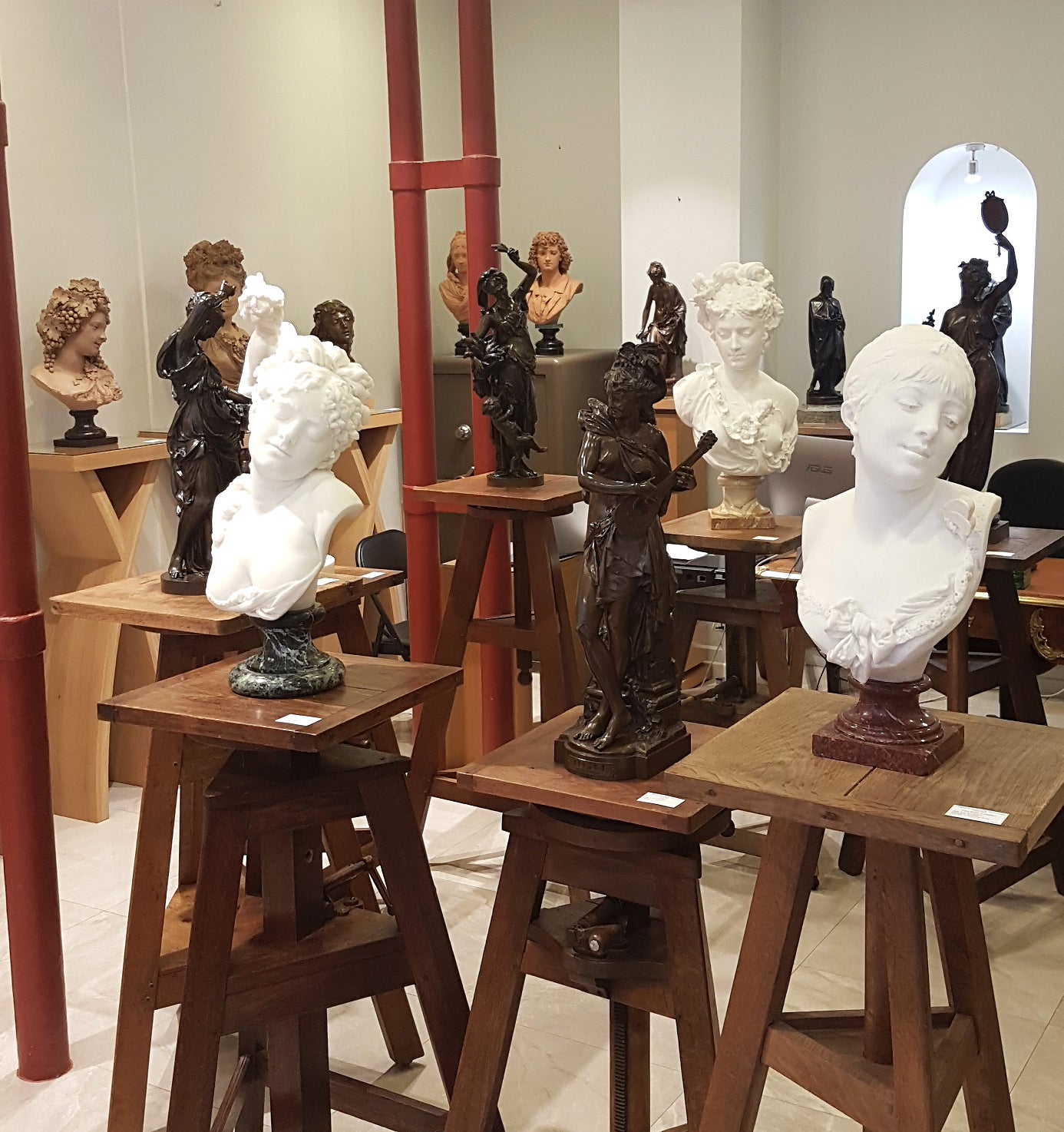
About the Seller
5.0
Recognized Seller
These prestigious sellers are industry leaders and represent the highest echelon for item quality and design.
Established in 1992
1stDibs seller since 2023
11 sales on 1stDibs
Typical response time: 12 hours
- ShippingRetrieving quote...Shipping from: PARIS, France
- Return Policy
More From This Seller
View AllVery important enamel plaque
Located in PARIS, FR
Allegories of Carnal Love and Chaste Love
by Paul GRANDHOMME (1851-1944) and Alfred GARNIER (1848-1908)
Very important plaque in translucent and opaque polychrome enamel on copper,
with gold spangles and gold highlights.
Set in its original silver setting.
Presented in its original morocco leather box...
Category
1880s Renaissance Figurative Paintings
Materials
Enamel
The Secret
Located in PARIS, FR
The Secret
by Pierre-Félix FIX-MASSEAU (1869-1937)
Sculpture in bronze with a gilded patina
Signed on the side " Fix-Masseau "
Cast by " Siot-Paris " (with the foundry mark)
France...
Category
Late 19th Century Art Nouveau Figurative Sculptures
Materials
Bronze
Pandora's Secret
Located in PARIS, FR
Pandora's Secret
by Maurice BOUVAL (1863-1916)
Sculpture made in bronze with a nuanced dual patina, light –and dark brown
signed on the base " M. Bouval "
old edition cast
presente...
Category
Early 1900s Art Nouveau Nude Sculptures
Materials
Bronze
Allegory of Progress
By Louis Chalon
Located in PARIS, FR
Allegory of Progress
by Louis CHALON (1866-1940)
Bronze with dual patina
Raised on a yellow Siena marble base
Signed on the side of the base " L. Chalon "
Old period cast
France
ci...
Category
Early 1900s Art Nouveau Figurative Sculptures
Materials
Bronze
Courtly Love
By Theodore Deck
Located in PARIS, FR
"Courtly Love"
by Théodore Deck (1823-1891)
Rare pair of figurines representing two lovers in the Middle Ages
Polychrome glazed ceramic
Each stamped "Th.Deck" on the underside
Fran...
Category
Late 19th Century French School Figurative Sculptures
Materials
Ceramic
The Song
By Félix Charpentier
Located in PARIS, FR
"The Song" by Félix Charpentier (1858-1924)
A very fine bronze sculpture with nuanced dark brown patina
Signed "Fx. Charpentier"
Cast by "E. Colin & Cie Paris"
France
around 1900
he...
Category
Early 1900s Art Nouveau Figurative Sculptures
Materials
Bronze
You May Also Like
A Fine KPM Plaque of a Beautiful Woman
By Königliche Porzellan-Manufaktur (KPM)
Located in New York, NY
Depicting a shoulder-length portrait of a long haired beauty with green drapery about her shoulders
Origin: Germany
Date: 19th century
Signed: KPM in ver...
Category
19th Century Portrait Paintings
Materials
Porcelain
KPM Porcelain Plaque of a female "Lute Player"
Located in New York, NY
A large KPM gilt framed porcelain hand painted plaque depicting a lute player in Regency style dress, in an ornately carved Florentine Giltwood frame
Late 19th century
Signed "Gree...
Category
19th Century Portrait Paintings
Materials
Porcelain
KPM Porcelain Plaque Margarite after Angelo Asti
By Königliche Porzellan-Manufaktur (KPM)
Located in New York, NY
This large oval porcelain plaque by the renowned KPM porcelain makers depicts a young woman draped in classical peach toned robes and holding daisies; after Angelo Asti's Margarite p...
Category
19th Century Portrait Paintings
Materials
Porcelain
Antique German KPM porcelain panel of Judith with the Head of Holofernes
By KPM Porcelain
Located in London, GB
The image of Judith with the Head of Holofernes was a powerful source of inspiration for many of great European artists, and was captured superbly in August Riedel...
Category
Antique Late 19th Century German Porcelain
Materials
Porcelain, Giltwood
$42,084 Sale Price
30% Off
KPM Porcelain Plaque of Queen Louisa
Located in New York, NY
KPM Porcelain Plaque of Queen Louisa
Oval shape polychrome enamel hand painted porcelain plaque set in a carved giltwood frame
C. 1900
impressed KPM mark
Germany
Plaque 10.75" x...
Category
Late 19th Century Portrait Paintings
Materials
Porcelain, Wood
KPM Berlin Porcelain Plaque of a Beauty
By Königliche Porzellan-Manufaktur (KPM)
Located in New York, NY
KPM Berlin Porcelain Plaque of a Female Beauty
Finely painted rectangular portrait plaque after works by Angelo Asti of a brunette beauty, in diaphanous red and white drapery.
Late...
Category
19th Century Portrait Paintings
Materials
Porcelain
More Ways To Browse
Antique Plaque
19th Century Austrian Art Nouveau
Fontaine Antique
Antique Meter
Exhibition 1862
Bavarian Antique
Henry Ii
Antique Painting Of Children
The Imperial Palace Of China
Garden China Made In Japan
19th Century English Green Majolica
Antique Oven
Lamp Porcelain Bird And Flowers
Chinese Porcelain Lamp With Painted Flowers
Saint Jacques
Alhambra Antique
Blue And Gold Chinese Lamps
Iznik Antique
